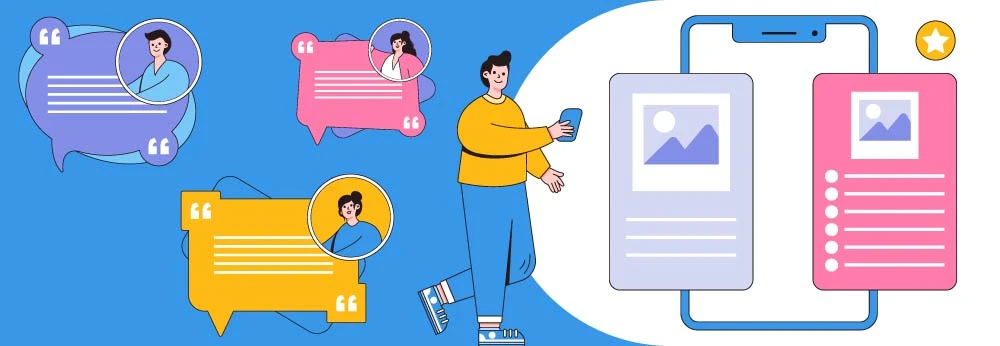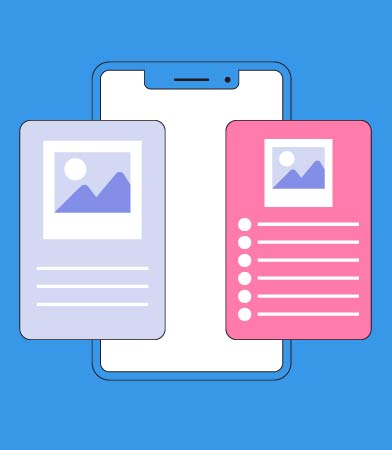.webp?2025-12-17T15:00:29.367Z)
Spotify Wrapped ideas make stats lovable

8 Mobile App Storytelling Techniques To Boost Engagement
Prudnikov Egor
Mobile app storytelling is an essential tool in engaging users and creating a memorable user experience. Storytelling techniques can help app developers connect with their target audience, communicate brand values, and create emotional resonance. This article will explore ten effective mobile app storytelling techniques that can boost engagement and drive conversions.
From understanding your audience's needs and preferences to incorporating user feedback, gamification, personalization, and social media, this article will provide tips and best practices for creating compelling narratives that resonate with users. Whether you're a seasoned app developer or just starting, these techniques can help you create an engaging user experience that keeps users coming back for more.
Know your audience

One of the essential components of effective mobile app storytelling is understanding your target audience. Knowing your audience's needs, preferences, and interests can help you create compelling stories that resonate with them and keep them engaged. To understand your audience, you need to conduct research and gather data on their demographics, behaviors, and motivations.
Start by identifying your target audience and defining their characteristics, such as age, gender, location, and interests. You can gather this information through market research, surveys, and user analytics. Analyzing your existing user data can provide valuable insights into your audience's behaviors, preferences, and patterns of app usage.
Once you have a clear understanding of your audience, you can use this knowledge to create stories that are relevant and meaningful to them. For example, if your target audience is primarily young adults interested in fitness, you might create a story that revolves around a character who overcomes fitness challenges or reaches a personal fitness goal. You could use interactive elements such as quizzes, polls, or social sharing to encourage engagement.
It's essential to make your stories relatable to your audience. A good story will connect with users on an emotional level and provide an immersive experience. Consider the tone and voice of your story, as well as the characters and plot. Are they aligned with your audience's interests and values?
Another crucial aspect of understanding your audience is knowing how they consume content. Do they prefer short-form or long-form stories? Do they enjoy interactive or passive experiences? Answering these questions can help you tailor your storytelling approach and make it more engaging and effective.
A narrative & engaging arc
Creating a narrative arc is an essential component of effective mobile app storytelling. A narrative arc is the structure of a story that follows a clear beginning, middle, and end. This structure provides a sense of coherence and closure to users, making the app experience more satisfying and memorable.
The beginning of a story sets the stage for the rest of the narrative. It should introduce the characters, setting, and conflict. This is an opportunity to capture the user's attention and draw them into the story. A compelling opening can be a hook, such as a surprising fact, an intriguing question, or a compelling anecdote.
The middle of the story develops the plot and characters. It's where the conflict is introduced and developed, leading to a climax or turning point. This is an opportunity to build tension and create emotional resonance with the user. The middle of the story can include interactive elements such as quizzes, polls, or mini-games that encourage engagement and immersion.
The end of the story provides closure and resolution. It's where the conflict is resolved, and the characters learn a lesson or reach a goal. The ending should provide a sense of satisfaction to the user and leave them with a positive impression of the app. This is an opportunity to encourage user actions and conversions, such as sharing on social media or leaving a review.
Structuring your story with a clear narrative arc is essential to creating a satisfying user experience. It helps users understand the purpose and message of the app and creates a sense of coherence and closure. It also helps developers stay focused on the goals of the app and ensure that the storytelling is effective and engaging.
Don’t forget about the visuals
Visual storytelling is a powerful technique for engaging users in mobile apps. It involves using images, videos, and animations to convey a story and enhance the user experience. Visuals can help to convey emotions, illustrate complex concepts, and provide context and depth to the app's narrative.
When incorporating visuals into your app's narrative, it's important to consider the quality and relevance of the images, videos, and animations used. High-quality visuals can increase the user's engagement and improve their perception of the app's quality. Relevance is also crucial, as the visuals should enhance the story and not distract from it.
Videos and animations can be used to provide interactive and immersive experiences for users. These can include animated tutorials, short films, and interactive games. The use of video can also be a powerful tool for storytelling, allowing developers to convey complex ideas and emotions through visual means.
Images can also be used to tell a story in mobile apps. These can include infographics, charts, and diagrams that illustrate key concepts or data. Images can also be used to create a visual style or theme that runs throughout the app, providing consistency and visual interest for users.
Incorporate user feedback

Incorporating user feedback is a crucial aspect of improving your mobile app's storytelling. User feedback can provide valuable insights into how users perceive your app's narrative, what they like or dislike, and what changes could improve their experience. Here are some ways to collect and analyze user feedback to improve your app's storytelling:
- Surveys: Surveys are an effective way to gather feedback from users. They can be sent via email, in-app notifications, or pop-ups. Surveys can be used to ask specific questions about the app's narrative and the user's experience with it.
- Reviews and ratings: App store reviews and ratings can provide valuable feedback on the app's storytelling. Developers can use this feedback to identify patterns and make changes to improve the app's narrative.
- User testing: User testing involves observing users as they interact with the app's narrative. This can help developers identify areas where users are confused or disengaged and make changes to improve the app's narrative.
- In-app analytics: In-app analytics can provide insights into how users are interacting with the app's narrative. Developers can use this data to identify areas where users are dropping off or spending less time and make changes to improve the app's narrative.
- Social media: Social media can be a valuable source of feedback on the app's narrative. Developers can monitor social media channels for mentions of the app and use this feedback to make changes to improve the app's narrative.
- Once user feedback has been collected, it's important to analyze it and make changes accordingly. Here are some steps to analyze user feedback:
- Identify patterns: Look for patterns in the feedback to identify common themes and issues.
- Prioritize feedback: Prioritize feedback based on its impact on the app's narrative and the number of users affected.
- Make changes: Use the feedback to make changes to the app's narrative. Test these changes with a subset of users before implementing them across the app.
Visual content is essential
Visual storytelling plays a critical role in mobile apps, as it can convey complex ideas and emotions quickly and effectively. Here are some tips for incorporating visuals into your app's narrative:
- Use images to enhance the story: Images can be used to support the narrative, provide context, and create emotional connections with users. Use high-quality images that are relevant to the story and appeal to your target audience.
- Include videos for more dynamic storytelling: Videos can be used to provide a more immersive and interactive experience for users. Consider using short videos to demonstrate how the app works, highlight key features, or showcase user testimonials.
- Use animations to add interest and interactivity: Animations can be used to make the app's narrative more engaging and interactive. Use simple animations to highlight key points or to add visual interest to the app's user interface.
- Ensure visuals are consistent with the app's branding: The visuals used in the app's narrative should be consistent with the app's branding and overall design aesthetic. Use colors, fonts, and imagery that align with the app's branding guidelines.
- Keep visuals simple and uncluttered: Too many visuals or overly complex visuals can distract users from the app's narrative. Keep visuals simple, uncluttered, and easy to understand.
- Use visuals to guide the user's journey: Visuals can be used to guide the user's journey through the app's narrative. Use visuals to highlight important information, provide context, and guide users to take desired actions.
Gamification mechanics
Mobile app developers are increasingly turning to gamification as a means of improving user engagement and retention. By leveraging game-like mechanics and incentives, developers can create a more immersive and rewarding experience for users. Here are some examples of how gamification can be used to enhance mobile app storytelling:
- Progress bars and badges: Incorporating progress bars and badges into an app's narrative can motivate users to continue using the app and striving towards their goals.
- Leaderboards and competition: Leaderboards can foster a sense of friendly competition among users, driving engagement and encouraging users to share their accomplishments on social media.
- Quests and missions: Quests and missions can provide users with a sense of purpose and direction, encouraging them to engage with the app and complete certain tasks or challenges.
- Rewards and incentives: Offering rewards or incentives for achieving certain milestones or completing certain tasks can create a sense of accomplishment and satisfaction for users.
- Story-based games: Story-based games that incorporate branching narratives and choices can create a more personalized experience for users and increase engagement.
By leveraging these gamification techniques, developers can create a more immersive and rewarding experience for users. However, it's important to ensure that the gamification elements don't overshadow the app's core purpose and that they are integrated in a way that feels organic and meaningful to users.
Personalization is the key
Personalization is a powerful tool in mobile app storytelling that can significantly increase user engagement and satisfaction. By tailoring the app's narrative to the individual user, you can create a more immersive and relevant experience that speaks directly to their interests, preferences, and needs.
One effective technique for personalizing your app's narrative is to use data-driven insights to understand user behavior and preferences. By analyzing user data, you can identify patterns and trends that can inform the development of personalized storytelling elements. For example, if you notice that a particular user spends a lot of time browsing content related to a specific topic, you can tailor the app's narrative to highlight that topic and create a more engaging experience.
Another way to personalize your app's storytelling is to offer users the ability to customize their experience. This can include options such as selecting their preferred language, choosing a personalized avatar or theme, or selecting their favorite types of content. By providing users with a sense of control over their experience, you can create a more engaging and memorable storytelling experience.
Personalization can also be achieved through the use of targeted messaging and notifications. By sending personalized messages to users based on their behavior and preferences, you can create a more meaningful and relevant experience. For example, you could send a message to a user who has been inactive for a while, reminding them of new content that is tailored to their interests.
Another technique for personalizing your app's narrative is to use contextual information to tailor the experience to the user's current situation. For example, if a user is traveling, you could provide them with personalized recommendations for local attractions, restaurants, and events. By creating a personalized experience that is relevant to the user's current situation, you can increase engagement and create a more memorable experience.
Multiple branches
Adding multiple branches to your app's storytelling can significantly impact user actions and conversions. By offering users multiple paths to follow, you can create a more dynamic and interactive experience that encourages exploration and engagement.
One way to use multiple branches is to offer users different options for completing a task or achieving a goal. For example, if your app offers a quiz or survey, you could provide users with multiple answer choices that lead to different outcomes or follow-up questions. By allowing users to choose their own path, you can create a more personalized experience that feels tailored to their interests and needs.
Another way to use multiple branches is to offer users different storylines or endings based on their actions or choices. This can create a sense of suspense and anticipation as users explore different paths and discover the consequences of their decisions. By offering users a variety of possible outcomes, you can create a more engaging and memorable experience that encourages repeat visits and increased user loyalty.
Overall, using multiple branches can add a sense of excitement and exploration to your app's storytelling, and can have a significant impact on user actions and conversions. By offering users a range of options and outcomes, you can create a more dynamic and personalized experience that encourages engagement and loyalty.
All in all

In conclusion, mobile app storytelling is a crucial element in engaging users and driving conversions. By understanding your audience, creating a compelling narrative arc, using visuals, incorporating user feedback, leveraging gamification, utilizing personalization, integrating social media, providing context, and using multiple branches, you can create an immersive and engaging experience that resonates with users and drives desired actions.
Effective storytelling can help you stand out in a crowded app market, increase user satisfaction and retention, and ultimately drive business success. By incorporating these techniques into your app's storytelling, you can create a more dynamic and personalized experience that encourages exploration and engagement.
It's important to keep in mind that effective storytelling requires a deep understanding of your audience's needs, preferences, and interests. By leveraging data-driven insights, user feedback, and other tools, you can create a more personalized experience that speaks directly to your users.

